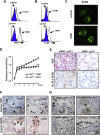Identification of oxidative stress and Toll-like receptor 4 signaling as a key pathway of acute lung injury
- PMID: 18423196
- PMCID: PMC7112336
- DOI: 10.1016/j.cell.2008.02.043
Identification of oxidative stress and Toll-like receptor 4 signaling as a key pathway of acute lung injury
Abstract
Multiple lung pathogens such as chemical agents, H5N1 avian flu, or SARS cause high lethality due to acute respiratory distress syndrome. Here we report that Toll-like receptor 4 (TLR4) mutant mice display natural resistance to acid-induced acute lung injury (ALI). We show that TLR4-TRIF-TRAF6 signaling is a key disease pathway that controls the severity of ALI. The oxidized phospholipid (OxPL) OxPAPC was identified to induce lung injury and cytokine production by lung macrophages via TLR4-TRIF. We observed OxPL production in the lungs of humans and animals infected with SARS, Anthrax, or H5N1. Pulmonary challenge with an inactivated H5N1 avian influenza virus rapidly induces ALI and OxPL formation in mice. Loss of TLR4 or TRIF expression protects mice from H5N1-induced ALI. Moreover, deletion of ncf1, which controls ROS production, improves the severity of H5N1-mediated ALI. Our data identify oxidative stress and innate immunity as key lung injury pathways that control the severity of ALI.
Figures







Comment in
-
A TRIFfic perspective on acute lung injury.Cell. 2008 Apr 18;133(2):208-10. doi: 10.1016/j.cell.2008.04.006. Cell. 2008. PMID: 18423191 Free PMC article.
-
Loss of TLR4 does not prevent influenza A-induced mortality.Am J Respir Crit Care Med. 2014 May 15;189(10):1280-1. doi: 10.1164/rccm.201401-0193LE. Am J Respir Crit Care Med. 2014. PMID: 24832747 Free PMC article. No abstract available.
Similar articles
-
A TRIFfic perspective on acute lung injury.Cell. 2008 Apr 18;133(2):208-10. doi: 10.1016/j.cell.2008.04.006. Cell. 2008. PMID: 18423191 Free PMC article.
-
Inhaled birch pollen extract induces airway hyperresponsiveness via oxidative stress but independently of pollen-intrinsic NADPH oxidase activity, or the TLR4-TRIF pathway.J Immunol. 2013 Jul 15;191(2):922-33. doi: 10.4049/jimmunol.1103644. Epub 2013 Jun 17. J Immunol. 2013. PMID: 23776177 Free PMC article.
-
The TLR4-TRIF pathway protects against H5N1 influenza virus infection.J Virol. 2012 Jan;86(1):19-24. doi: 10.1128/JVI.06168-11. Epub 2011 Oct 26. J Virol. 2012. PMID: 22031950 Free PMC article.
-
Targeting TLR4 Signaling to Blunt Viral-Mediated Acute Lung Injury.Front Immunol. 2021 Jul 2;12:705080. doi: 10.3389/fimmu.2021.705080. eCollection 2021. Front Immunol. 2021. PMID: 34282358 Free PMC article. Review.
-
Oxidized phospholipids in control of inflammation and endothelial barrier.Transl Res. 2009 Apr;153(4):166-76. doi: 10.1016/j.trsl.2008.12.005. Epub 2009 Jan 21. Transl Res. 2009. PMID: 19304275 Free PMC article. Review.
Cited by
-
Selenium to selenoproteins - role in COVID-19.EXCLI J. 2021 Apr 16;20:781-791. doi: 10.17179/excli2021-3530. eCollection 2021. EXCLI J. 2021. PMID: 34040501 Free PMC article. Review.
-
Immunopathogenesis of Coronavirus-Induced Acute Respiratory Distress Syndrome (ARDS): Potential Infection-Associated Hemophagocytic Lymphohistiocytosis.Clin Microbiol Rev. 2020 Oct 14;34(1):e00074-20. doi: 10.1128/CMR.00074-20. Print 2020 Oct 14. Clin Microbiol Rev. 2020. PMID: 33055229 Free PMC article. Review.
-
The inflammatory response triggered by Influenza virus: a two edged sword.Inflamm Res. 2017 Apr;66(4):283-302. doi: 10.1007/s00011-016-0996-0. Epub 2016 Oct 15. Inflamm Res. 2017. PMID: 27744631 Review.
-
Expression quantitative trait Loci for extreme host response to influenza a in pre-collaborative cross mice.G3 (Bethesda). 2012 Feb;2(2):213-21. doi: 10.1534/g3.111.001800. Epub 2012 Feb 1. G3 (Bethesda). 2012. PMID: 22384400 Free PMC article.
-
Lian Hua Qing Wen Capsules, a Potent Epithelial Protector in Acute Lung Injury Model, Block Proapoptotic Communication Between Macrophages, and Alveolar Epithelial Cells.Front Pharmacol. 2020 Sep 23;11:522729. doi: 10.3389/fphar.2020.522729. eCollection 2020. Front Pharmacol. 2020. PMID: 33071777 Free PMC article.
References
-
- Adachi O., Kawai T., Takeda K., Matsumoto M., Tsutsui H., Sakagami M., Nakanishi K., Akira S. Targeted disruption of the MyD88 gene results in loss of IL-1- and IL-18-mediated function. Immunity. 1998;9:143–150. - PubMed
-
- Akira S., Uematsu S., Takeuchi O. Pathogen recognition and innate immunity. Cell. 2006;124:783–801. - PubMed
-
- Bailey T.C., Da Silva K.A., Lewis J.F., Rodriguez-Capote K., Possmayer F., Veldhuizen R.A. Physiological and inflammatory response to instillation of an oxidized surfactant in a rat model of surfactant deficiency. J. Appl. Physiol. 2004;96:1674–1680. - PubMed
-
- Beigel J.H., Farrar J., Han A.M., Hayden F.G., Hyer R., de Jong M.D., Lochindarat S., Nguyen T.K., Nguyen T.H., Tran T.H., et al. Avian influenza A (H5N1) infection in humans. N. Engl. J. Med. 2005;353:1374–1385. - PubMed
-
- Binder C.J., Chang M.K., Shaw P.X., Miller Y.I., Hartvigsen K., Dewan A., Witztum J.L. Innate and acquired immunity in atherogenesis. Nat. Med. 2002;8:1218–1226. - PubMed
Publication types
MeSH terms
Substances
LinkOut - more resources
Full Text Sources
Other Literature Sources
Molecular Biology Databases
Miscellaneous

